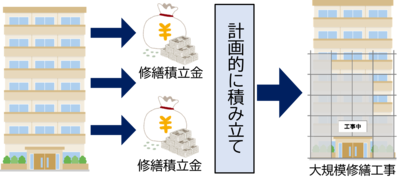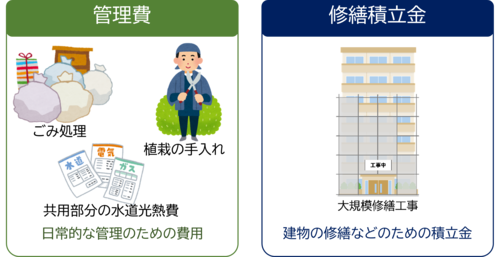- Yokohama-shi Top Page
- Living and Procedures
- Housing and Living
- Housing
- Yokohama Condominium Portal
- Maintain and manage
- Management Rules and Long-Term Repair Plan
- What is the reserve fund for repair?
Here's the text.
What is the reserve fund for repair?
This page is created based on the Ministry of Land, Infrastructure, Transport and Tourism's "Guidelines on Reserve for Repair of Condominiums" (revised in June 2024).
Last Updated June 21, 2024
What is the reserve fund for repair?

What is the reserve fund for repair?
Repairing common areas of condominiums often requires a great deal of money, and collecting expenses collectively when performing repair work is a heavy burden for section owners. In addition, consensus building may be difficult, and in the worst case, the necessary construction may not be possible due to lack of funds.
In order to avoid such a situation, the “repair reserve fund” is a long-term plan to reserve the costs required for repair work expected in the future.
The amount of the repair reserve must be set based on the "long-term repair plan" so that sufficient funds can be provided at the time of planning.
Estimated reserve for repair
The amount of the repair reserve fund varies depending on the size of the building, the content of the equipment, the number of years elapsed, etc., but the “Guidelines on Reserve for Repair of Condominiums” formulated by the Ministry of Land, Infrastructure, Transport and Tourism provides an estimate of the amount.
Excerpts from guidelines on reserve for repair of condominiums (Ministry of Land, Infrastructure, Transport and Tourism)
Method for calculating the average amount of reserve for repair over the entire long-term repair plan period (unit price per m2 per month)
(A+B+C)÷X÷Y
A: Balance of repair reserve at the beginning of the plan period (yen)
B: Total amount of repair reserve funds collected during the planning period (yen)
C: Total amount of transfer from dedicated usage fees, etc. throughout the planning period (yen)
X: Total floor area of condominiums (m2)
Y: Plan period (month) of long-term repair plan
Average amount calculation sheet for repair reserve (Excel: 14KB)
Please also use this calculation sheet to calculate the average amount.
Estimated average amount of repair reserve funds for the entire planning period of the long-term repair plan (excluding mechanical parking lots)
| Number of floors above ground / total floor area | Repair reserve amount per occupied area per month | |||
|---|---|---|---|---|
| Width that includes two-thirds of the case | Average value | |||
| [Less than 20th floor] | Less than 5,000 m2 | 235 yen to 430 yen/m2/month | ¥335/m2/month | |
| 5,000㎡~10,000㎡ | 170 yen to 320 yen/m2/month | 252 yen/m2/month | ||
| 10,000㎡~20,000㎡ | 200-330 yen/m2/month | ¥271/m2/month | ||
| 20,000 m2 or more | 190 yen to 325 yen/m2/month | 255 yen/m2/month | ||
| [20th floor or higher] | 240 yen to 410 yen/m2/month | 338 yen/m2/month | ||
- Since the cases vary greatly, the "average value" and "width that includes two-thirds of the cases" are also shown from the viewpoint of indicating the range where most of the cases can fit. In addition, there is a method of expressing the range by standard deviation along with the average value, but since the variation in the case does not become a regular distribution, here we give priority to the clarity and set the inclusion width of two-thirds from the center (width excluding one-sixth of the case). The value of this package included width is shown in units of 5 yen.
- Ultra-high-rise condominiums (generally 20 floors above ground) require special scaffolding for repairing outer walls, etc., and repair work costs tend to increase due to the increase in the proportion of common areas. Therefore, the guidelines for [20 floors or more above ground] are shown separately. Condominiums with [less than 20 floors above ground] are classified as 5,000m2, 10,000m2, and 20,000m2, as the level of repair work costs tends to differ depending on the size of the total floor area of construction. Is shown.
Additional amount when there is a mechanical parking lot
Monthly repair work costs per unit of mechanical parking lots (see table below) x number ÷ Total floor area of condominiums (m2)
※If maintenance and repair costs for parking lots and parking fees are accounted for separately from management fee and reserve funds, repair costs for mechanical parking lots will be covered by parking lot usage fees. If so, you do not need to add them.
| Model of mechanical parking | Repair costs for mechanical parking lots (Monthly per unit) |
|---|---|
| 2 steps (1 step pit) lifting type | 6,450 yen/vehicle/month |
| 3 steps (2 steps of pit) lifting type | 5,840 yen/vehicle/month |
| 3-stage (1-step pit) lift-down type | 7,210 yen/vehicle/month |
| 4 steps (2 steps of pits) lifting and lateral | 6,235 yen/vehicle/month |
| Elevator system (vertical circulation system) | 4,645 yen/vehicle/month |
| Others | 5,235 yen/vehicle/month |
- "Repair construction costs per vehicle in mechanical parking lots" is a numerical value (displayed in units of 5 yen) calculated from collected long-term repair plans (117 cases).
- There are various types of mechanical parking lots, such as outdoor / indoor, ground / underground, etc., so please refer to the repair work costs as appropriate while keeping in mind that they are highly individual.
Method of reserve fund for repair
The reserve method for repair reserves includes a method in which the total amount of repair work costs planned in the long-term repair plan is equally accumulated during the planning period (equivalent funding method), as well as a gradual reduction in the initial reserve amount. There is a method of raising the amount (stage increase funding method).
According to the “Comprehensive Survey of Condominiums in FY2018” conducted by the Ministry of Land, Infrastructure, Transport and Tourism, the adoption ratio of the reserve fund for repair of entire condominiums was 41.4% for the “Equal Reserve System” and 43.4% for the “Step Increased Reserve System”. I am. According to the guidelines of the Ministry of Land, Infrastructure, Transport and Tourism, from the viewpoint of securing stable reserves for repairs in the future, an equal funding method is desirable, but the proportion of new condominiums in the completion year adopts a gradual increase funding method. Is increasing.
Revision of reserve for repair
Generally, when selling a condominium, the condominium company indicates the amount of the repair reserve to the condominium purchaser, but the condominium purchaser does not necessarily have sufficient knowledge of the repair reserve, etc. The reserve may be set low.
The step-up funding method is based on an increase in the reserve fund for repairs in the future. In the event of an increase, consensus among the section owners may not be formed and the reserve for repairs may be insufficient.
Materials and equipment used in condominiums will change with the times in line with social changes and technological improvements. In addition, the details of repair work, construction methods, repair cycles, etc. will also change with the progress of new construction methods and technological development.
Regardless of what kind of funding method is adopted, it is necessary to periodically review the long-term repair plan and re-establish the reserve fund based on it.
Appropriate way of raising by step-by-step funding method
Condominiums become older, and repair costs increase due to aging of buildings and equipment. In addition, due to the aging of division owners, it is possible that the burden of increased repair costs will be difficult. Therefore, it is desirable to complete the increase as soon as possible with regard to the step-by-step funding scheme.
The Ministry of Land, Infrastructure, Transport and Tourism has shown the following approach to the appropriate increase in the step-by-step funding system with the aim of completing the early increase in the repair reserve fund by raising the feasibility and guiding it to the equal funding system. I am.
Concept of raising
The amount collected per month in the stage increase funding method is based on the amount per month when the equal funding method is used as the base amount, the initial amount of the plan is 0.6 times or more of the base amount, and the final amount of the plan is 1.1 times the base amount Within.
Specific calculation method
0.6×D ≤ E and 1.1×D ≥ F
※A: Total amount of repair reserve funds collected during the planning period (yen)
B: Total floor area of condominiums (m2)
C: Plan period for long-term repair plan
D: Average amount of reserve for repair per month for the entire planning period = A / B / C (yen / m2 / month)
E: Minimum amount of reserve for repair per month for the entire planning period (yen/m2/month)
F: The maximum amount of reserve for repair per month for the entire plan period (yen/m2/month)
The review of long-term repair plans in light of rising construction costs, etc. does not limit the significant increase in the current repair reserve amount for proper management.
Based on the Ministry of Land, Infrastructure, Transport and Tourism's “Guidelines on Reserve for Repair of Condominiums” (revised in June 2024).
Difference between management fee and reserve for repairs

Difference between management fee and reserve for repairs
The repair reserve and management fee are used differently.
However, it is the same that it is money for maintenance of common areas (corridors, elevators, entrances, etc.) rather than private areas of condominiums (in the rooms of each dwelling unit).
In addition to cleaning, garbage disposal and planting, management fee is used for daily management, such as utilities expenses for common areas, fire and non-life insurance premiums, while the reserve for repairs is a reserve for repairing buildings such as large-scale repairs.
Since the reserve fund and the management fee are used differently, they must be managed separately. (Category Accounting)
There is a possibility that large-scale repair work or sudden repair work is required if only the management fee is collected, large temporarymanagement fee may be required or a large increase in the reserve fund.
Long-term repair plan
Please see here for the long-term repair plan.
What is the Long-Term Repair Plan?
Inquiries to this page
Building Bureau Housing Department Housing Reconstruction Section
Telephone: 045-671-2954
Telephone: 045-671-2954
Fax: 045-641-2756
Email address: kc-jutakusaisei@city.yokohama.lg.jp
Page ID: 228-707-203







